Introduction: Beyond Regular and Merino
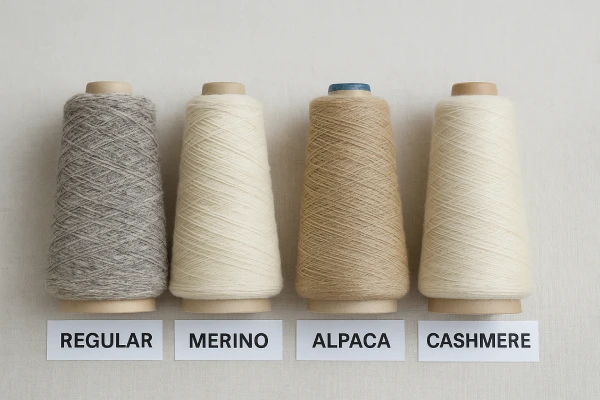
When people think about wool socks, the first materials that come to mind are usually regular wool or the ever-popular Merino wool. These two have dominated the market for decades, but the truth is that the world of wool is far more diverse. From alpaca to cashmere, and even to specialty fibers like yak or angora, there is a wide spectrum of natural fibers that can dramatically change how socks perform and how they are positioned in the market.
For buyers, wholesalers, and private labels sourcing through OEM/ODM manufacturing, understanding these differences is essential. Choosing the right wool material not only impacts product performance but also determines your brand’s position, target market, and profit margins. This guide provides a complete overview of the main types of wool for socks, key traits, and buyer impact.
Why Wool Matters in Socks Manufacturing
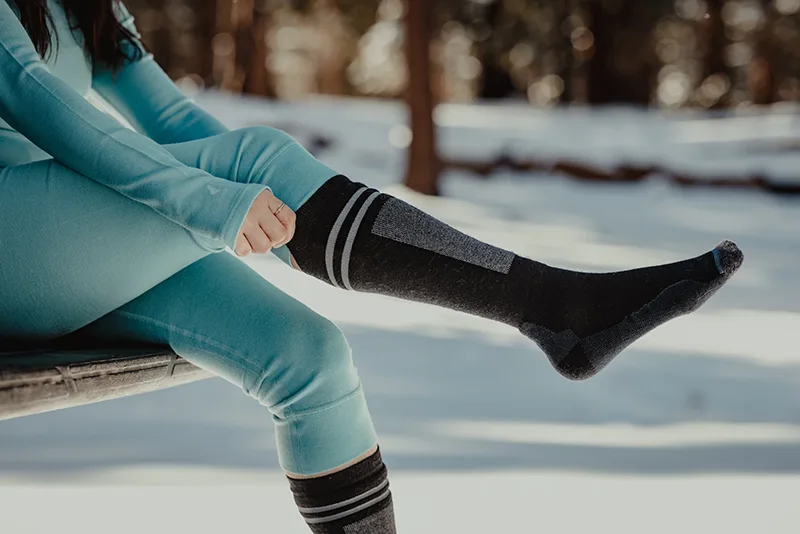
Wool is one of the oldest and most versatile natural fibers known to mankind, and its role in socks manufacturing remains unrivaled. Key advantages include:
- Thermal regulation: Wool keeps feet warm in cold weather while remaining breathable in warmer conditions.
- Moisture management: It absorbs and wicks away sweat, preventing clamminess and reducing odor.
- Comfort and softness: Fine wools such as Merino or Cashmere offer a luxurious wearing experience.
- Durability: With proper processing and blending, wool socks can withstand repeated use and washing.
- Sustainability: Wool is a renewable, biodegradable material, aligning with modern eco-conscious consumer demand.
However, not all wool is the same. Each variety offers a unique combination of performance, comfort, and cost, which is why understanding wool material categories is crucial for OEM buyers.
Wool Material Categories for Socks
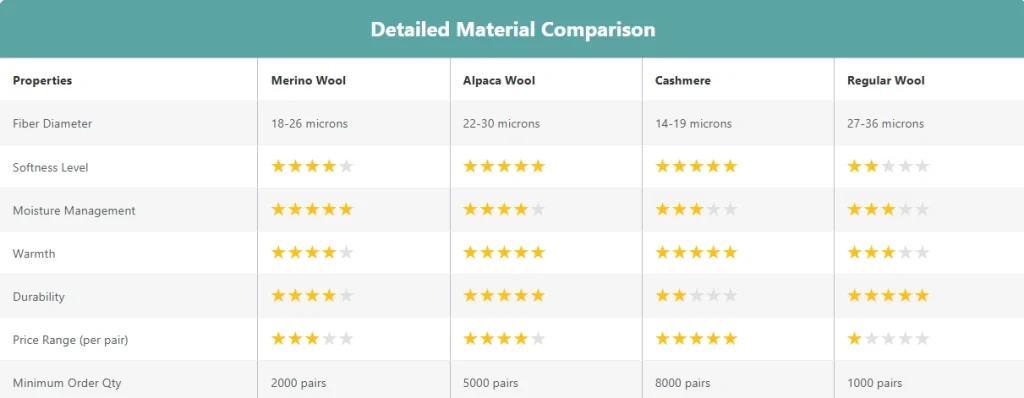
Regular Wool
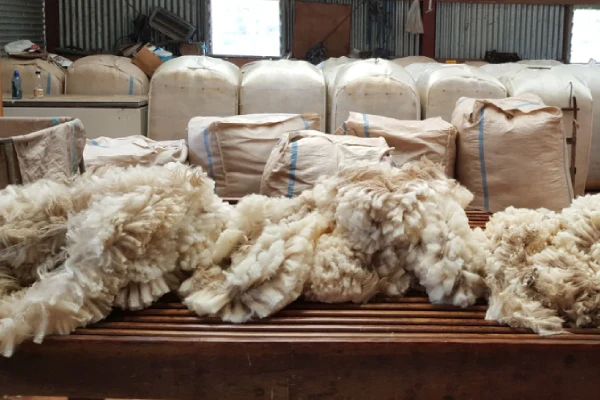
Regular wool is the most cost-effective option for durable, warm socks at scale. Regular wool comes from standard sheep breeds and is known for its coarser fiber structure. With a fiber diameter ranging from 27–35 μm, it has been the traditional choice for wool socks for generations. Perfect for mass-market retailers, workwear suppliers, and entry-level winter socks collections, where affordability and scalability are more important than luxury positioning.
Strengths
- High durability and resistance to wear make it suitable for heavy-duty use
- Reliable warmth, especially in colder climates
- Cost-effective, ensuring affordable wholesale pricing
- Accessible with relatively low MOQ, ideal for bulk production
Limitations
- A coarser texture may feel itchy for sensitive users
- Less effective in moisture management compared to finer wools
- Perceived as a “basic” option, with limited premium appeal
Merino Wool
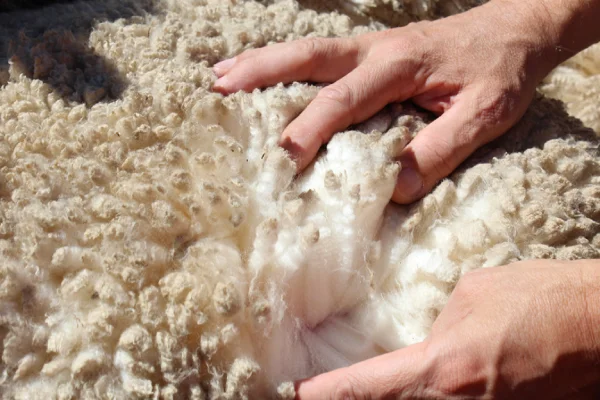
Merino wool, sourced mainly from Australia and New Zealand, is renowned for its fineness and versatility. With fibers typically 18–26 μm in diameter, it is one of the most popular and market-recognized options for socks today. The most versatile choice, Merino socks work well for sportswear, outdoor retailers, and general apparel brands looking for broad consumer appeal.
Strengths
- Exceptional softness and comfort, without the itchiness of coarser wools
- Superior moisture-wicking and odor resistance, ideal for active wear
- Effective temperature regulation, suitable for both cold and warm conditions
- Well-known by consumers, making it easier to market and sell globally
- Naturally resistant to pilling, keeping socks looking new for longer
Limitations
- Higher cost compared to regular wool, reducing margin in price-sensitive channels
- Less durable when used alone; often blended with nylon for reinforcement
- High market saturation may make it harder to stand out without strong branding
Alpaca Wool
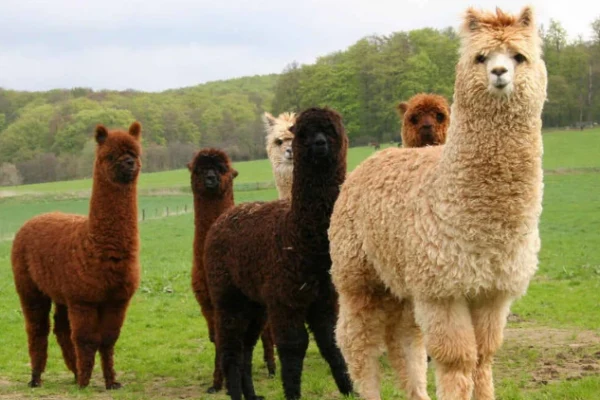
Alpaca wool comes from the high-altitude regions of South America. Its fibers are naturally hollow, offering outstanding insulation with minimal weight. With a fiber diameter of 20–28 μm, alpaca wool provides a unique balance of warmth and comfort. Best for premium winterwear, boutique outdoor gear, and niche luxury collections, where uniqueness and exclusivity are valued more than scale.
Strengths
- Excellent insulation while remaining lightweight
- Hypoallergenic, containing little lanolin, making it ideal for sensitive skin
- Exotic appeal, often marketed as a luxury or premium fiber
- Natural sheen that enhances the visual appeal of socks
Limitations
- Less elastic than Merino, which can affect shape retention
- Weaker moisture-wicking properties limit suitability for performance wear
- Supply constraints may result in higher costs and longer lead times
Cashmere Wool
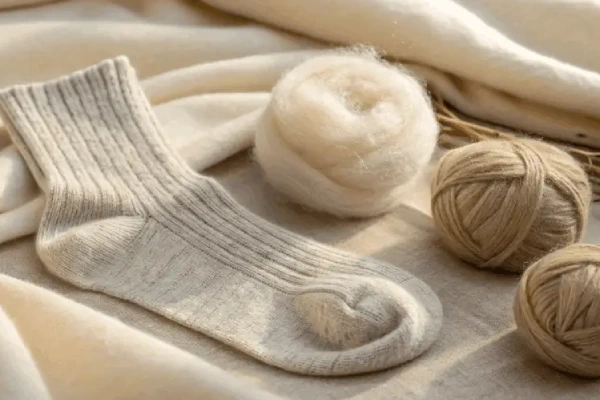
Cashmere is sourced from the fine undercoat of cashmere goats in Central Asia, with fibers as fine as 14–16 μm. Cashmere is the benchmark for luxury: ultra-soft, light, and warm. Ideal for luxury fashion brands, gift collections, and premium apparel labels, where exclusivity and branding power outweigh concerns about cost or durability.
Strengths
- Exceptional softness and comfort, delivering a premium feel
- Excellent warmth-to-weight ratio
- Strong luxury branding, allowing for high-margin positioning
- Instant consumer recognition as a prestige material
Limitations
- Among the most expensive wool fibers, it significantly raises production costs
- Lower durability if used alone, often requiring blends for reinforcement
- Higher MOQ and sourcing challenges due to limited supply
- The target market is niche, with limited mass-market applicability
Other Specialty Wools
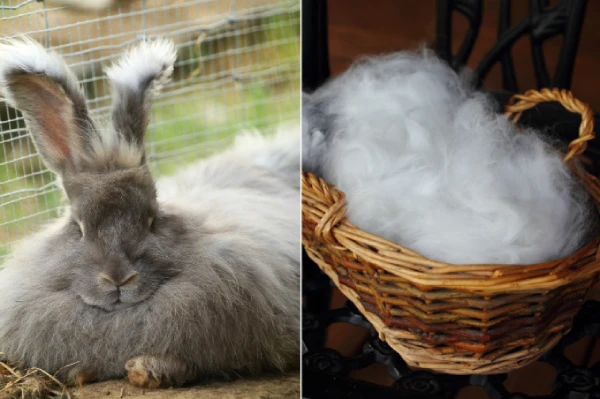
In addition to the four main wool types, several other specialty fibers exist that bring unique properties and storytelling opportunities. While less common in large-scale production, they can help brands carve out distinctive product lines. Best suited for boutique brands, niche outdoor labels, or limited-edition collections that emphasize exclusivity and storytelling over volume sales.
- Yak Wool: Strong, warm, and dense, ideal for extreme cold-weather wear
- Angora Wool: Ultra-soft and fluffy, offering a delicate luxury feel, best used in blends
- Other Rare Fibers (e.g., camel hair, qiviut): Extremely warm and exclusive, though limited in availability
Limitations
- Many specialty fibers lack elasticity or durability, requiring blending
- Limited and inconsistent supply can drive up costs
- Lower consumer awareness means niche rather than mass-market potential
Why This Matters for Buyers
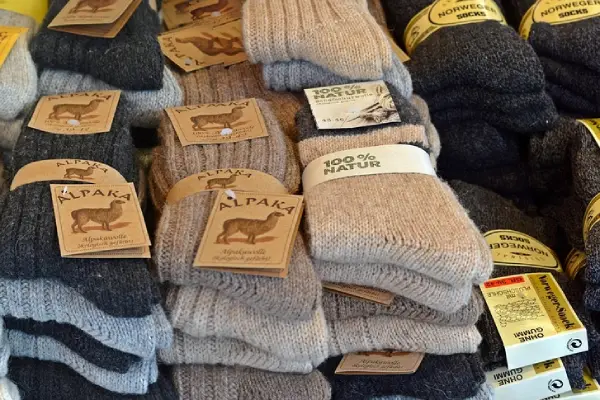
In short, understanding wool categories helps you capture new customers, protect profitability, and stand out in a crowded market. Choosing the right wool material is more than a technical detail—it directly impacts your business.
- Market Positioning: Regular and Merino cover mainstream demand, but alpaca and cashmere open doors to premium and luxury markets.
- Profit Margins: Basic wools keep costs low, while premium fibers justify higher retail pricing and stronger brand value.
- Risk Management: Relying on one material (e.g., Merino) limits flexibility; diversifying across wool types ensures supply stability.
- Consumer Perception: Today’s buyers recognize material differences—offering variety builds trust and differentiates your brand.
FAQ: Wool Socks Materials
What are the benefits of wool socks compared to cotton or synthetic fibers?
Wool socks provide better warmth, breathability, and moisture control than cotton or synthetics. Wool sock materials also resist odor naturally, making them ideal for performance and outdoor use.
How do Merino and Alpaca wool compare in performance and comfort?
Merino wool socks excel in softness, sweat management, and versatility. Alpaca wool socks are warmer, hypoallergenic, and lighter, positioning them as a premium upgrade.
Is Merino wool more durable than cotton?
Yes—Merino wool socks last longer due to elasticity and shape recovery. Unlike cotton socks, they resist wear, hold fit, and stay comfortable through repeated washing.
Why use wool blends in socks?
Wool blends improve durability, elasticity, and cost control while keeping natural comfort. Common blends like Merino+nylon create strong, soft wool socks suitable for wholesale buyers.
Is Alpaca a meaningful upgrade over Merino?
Alpaca wool socks offer higher warmth-to-weight and luxury appeal, while Merino remains mainstream. For brands, adding alpaca expands beyond standard wool sock materials.
Conclusion
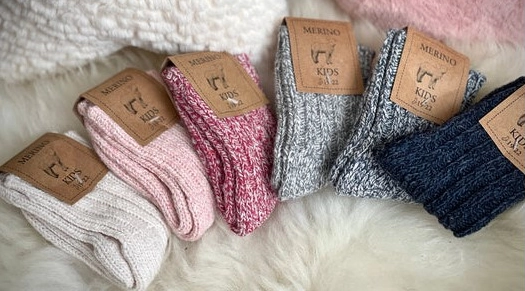
The world’s types of wool for socks go far beyond regular and Merino. By understanding the full spectrum—Alpaca, Cashmere, and even specialty wools—you gain the knowledge to create products that align with your market strategy and brand goals.
If you are a wholesale buyer, private label, or brand seeking an OEM/ODM wool socks supplier, we can help you design and manufacture the perfect collection.
👉 At Max Hosiery, we specialize in OEM/ODM wool socks manufacturing with full material options, flexible MOQs, and tailored designs. Contact us today to request samples, discuss your sourcing needs, or explore how we can support your next custom wool sock line.
